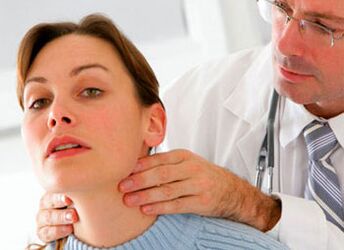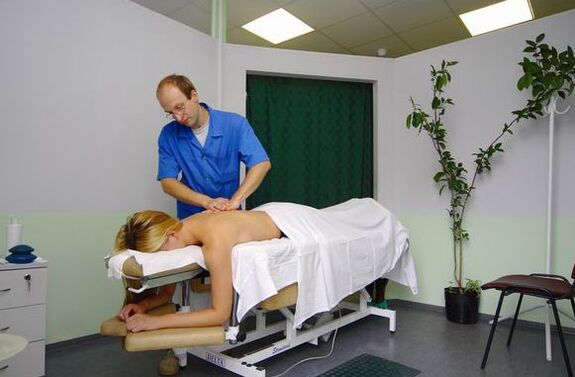Unfortunately, many are familiar with osteochondrosis. This disease has become a true disease of the century. First of all, a sedentary lifestyle is to blame for osteochondrosis, which for most of us is becoming the norm. Problem number two is an unbalanced diet and alcohol abuse. Oddly enough, but it is food that has a direct effect on the state of the spine.
The most common type of this disease is cervical osteochondrosis. The cervical spine is an area of special risk, since the size of the vertebrae is smaller here than in other areas of the spine. Also, the neck is not as muscular as the rest of the back.
Development of cervical osteochondrosis.

The danger is that at first a person often does not even realize that he is sick. At the first stage of the development of the disease, the intervertebral discs experience slight destructive effects: the elasticity decreases, the first small cracks appear, the height of the disc becomes smaller (as a result, the nerve roots begin to compress). There is discomfort in the neck or aching pain.
If the first degree of osteochondrosis passes into the second, the pain progresses. This is because the destruction of the intervertebral disc continues to progress, leading to subluxations of the neck vertebrae. You can follow the development of the disease, the so-called dropped head syndrome, which is characterized by severe pain. As a result, the patient has to support his head; in this position, the pain is somewhat weakened.
The third degree of cervical osteochondrosis has a number of even more unpleasant symptoms: nausea, "lumbago" in the neck, dizziness, weakening of the sensitivity of the hands and, of course, pain.
Exacerbation of osteochondrosis in the neck and its causes
Exacerbation of the disease can occur at any stage. The reason for this is usually:
- Sudden movements, excessive physical activity, heavy lifting. If a person suffering from osteochondrosis in the neck makes a sharp turn or tilts his head, it is not known exactly how his intervertebral discs will react.
- Situations of nervousness and stress. Often, stressful situations "ignite" diseases that are deeply rooted in us - cervical osteochondrosis is no exception.
- A massage performed by a non-professional. If you know that you suffer from osteochondrosis and you attend a session, it is your responsibility to warn the masseur about the disease. Otherwise, the consequences can be most unpredictable. And of course you can't entrust your back and neck to a masseur whose competence is in doubt.
- Changes of time and hypothermia. Especially often exacerbations of cervical osteochondrosis occur in the fall.
- Go to the bathroom during an exacerbation. In itself, a visit to the bath or sauna can be useful, since warming up often benefits the patient. But the desire to plunge into cold water or jump hot in the cold will have to be abandoned, since osteochondrosis will soon "thank you" with even greater aggravation.
- Advanced age. The intervertebral discs tend to wear out over the years, so the exacerbation of the disease in the elderly is not surprising.
- A state of abandonment of the disease. If osteochondrosis is not treated, exacerbations cannot be avoided.
Exacerbation symptoms

Symptoms of exacerbation of cervical osteochondrosis may be different; it all depends on the degree of progression of the disease. These can be pain in the parietal region, decreased sensitivity of the skin in the same area, pain in the middle of the neck, a feeling of heaviness in the tongue, pain in the clavicle and shoulder girdle.
In a particularly acute phase of the exacerbation, there may be respiratory failure and pain in the region of the heart or liver. If vertebral artery syndrome occurs, undulating headaches may appear, especially "pressing" the eyes, temples and ears. It happens that the exacerbation of cervical osteochondrosis causes pain only in the left half or only in the right half of the head, as happens with migraine. Another indicator is a characteristic cracking sound at the back of the head when the head is tilted or turned.
As for vision and hearing, fog may appear before the eyes, intermittent dots and spots. Ringing in the ears and dizziness are not ruled out.
If the pain spreads to the arm, muscle strength may be weakened. The pain can also be felt in the hand and fingers.
First aid for exacerbation of cervical osteochondrosis.

Treatment of cervical osteochondrosis during exacerbation should be prescribed by a professional. Therefore, if the worsening of the disease caught you when you were alone at home, it is better to call a doctor. Before your arrival, it is desirable to move minimally, the optimal solution is to lie in bed. You are allowed to take painkillers. These medications are designed to reduce pain and reduce inflammation that is present in the spine.
Also, the doctor may prescribe chondroprotectors; they should help stop destructive processes occurring on the disk. However, such drugs need to be taken for quite a long time - about six months. But they will help prevent the exacerbation of osteochondrosis.
Muscle relaxants - drugs that reduce pathological tension in the muscles - will not be superfluous. Vascular drugs, B vitamins, diuretics (with constant monitoring), and nootropic drugs are also commonly prescribed.
How long does an exacerbation last?
The phase of exacerbation for each person proceeds in its own way. The same applies to the duration of the attack. If the treatment of exacerbation of cervical osteochondrosis was started in a timely and correct manner, the peak of the disease is likely to subside within a few days. In more complex and advanced cases, the period of exacerbations can last for several weeks. If the disease is not treated and the matter is left to chance, there is a great danger that a second exacerbation will not be long in coming; in this case, the "calm" periods will be shorter and shorter. To prevent this from happening, it is recommended to prevent exacerbations.
How to reduce the probability of exacerbation?
A person who at least once suffered from an exacerbation of cervical osteochondrosis and felt the "charms" of it on himself should do everything to avoid repeated attacks. Treatment of cervical osteochondrosis during exacerbation should be intensive, but it does not follow from this that if the danger has passed, you can relax.

It will be useful to visit an experienced masseur, who should be told about problems with the neck in advance. If there is no opportunity to sign up for a massage, you can limit yourself to self-massage. To do this, it is recommended to make movements of caresses, kneading and vibrations in the neck area.
Finding a good chiropractor is a big problem. Therefore, if you know this, you can contact him. Treatment of exacerbation of cervical osteochondrosis, as well as preventive procedures, may include such manual effects:
- Relaxation massage, which is designed to relieve tension from tight muscles and warm them up well.
- Mobilization. The purpose of such an impact is to restore the functions of the joints with the help of traction.
- Handling. Its essence lies in the fact that the chiropractor produces a strong push in the area of the problem area, as a result of which the joint returns to its natural position.
Acupuncture can also be very useful in preventing the exacerbation of osteochondrosis in the neck. Naturally, only a specialist should perform such a procedure.
Diet also plays a role. Patients are advised to focus on foods rich in magnesium and calcium (ie, legumes, nuts, shellfish, fish, and dairy products). You will have to stop drinking excessively, since alcohol tends to negatively affect the circulatory system, which already suffers from osteochondrosis of the neck.
Lifestyle of a person suffering from cervical osteochondrosis
Regarding daily life and daily routine, the following is recommended:
- Sleep on an orthopedic mattress with a small pillow under your head.
- A hot shower, sauna and bath are useful (except during the period of treatment of cervical osteochondrosis during exacerbation).
- Swimming is very useful: it helps relieve spasms and strengthens muscles.
- If you work sitting down, you should take breaks periodically to warm up. In addition, it is recommended even sitting down to try to change position every fifteen minutes.
- Hiking is useful, but it is better to refrain from jumping and running.
- Physical exercises, the goal of which is to strengthen the muscular corset of the neck, are the key to the fight against osteochondrosis.
Like any other ailment, cervical osteochondrosis should be treated as soon as possible. If the disease hid and "showed its claws" only when osteochondrosis had already begun to progress, do not despair. The tips above should definitely help you!


























